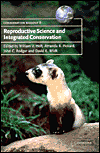

 |

|

Sold Out
Book Categories |
List of contributors; Foreword Richard Stone; Part I. Introduction: 1. Toward more effective reproductive science for conservation David E. Wildt, Susie Ellis, Donald Janssen and Jennifer Buff; Part II. Reproduction and Population Viability: Introduction; 2. Behaviour and reproduction Alan Dixson, Nancy Harvey, Marilyn Patton and Joanna Setchell; 3. Nutrition and its interaction with reproductive processes Tom G. McEvoy and John J. Robinson; 4. Environmental chemicals and the threat to male fertility in mammals: evidence and perspective Helen S. Baillie, Allan A. Pacey and Harry D. M. Moore; 5. Assessing the consequences of inbreeding for population fitness: past challenges and future prospects Andrea C. Taylor; 6. Impacts of inbreeding on components of reproductive success Karen Koeninger Ryan, Robert C. Lacy and Susan W. Margulis; 7. The major histocompatibility complex (MHC) in declining populations: an example of adaptive variation Philip Hedrick; 8. When is the birth rate the key factor associated with population dynamics? Tim Coulson and Elodie Hudson; Part III. Reproductive Techniques for Conservation Management: Introduction; 9. Reproductive and welfare monitoring for the management of ex-situ populations Amanda R. Pickard; 10. Non-invasive endocrine measures of reproduction and stress in wild populations Steven L. Monfort; 11. Ultrasound for analysis of reproductive function in wildlife species Thomas B. Hildebrandt, Janine L. Brown, Robert Hermes and Frank Goritz; 12. Role of embryo technologies in genetic management and conservation of wildlife Naida M. Loskutoff; 13. Application of nuclear transfer technology to wildlife species J. K. Critser, L. K. Riley and R. S. Prather; Part IV. Integrated Conservation Management: Introduction; 14. Integrating reproductive sciences into recovery programmes for declining and extinct marsupial populations Peter D. Temple-Smith; 15. Captive breeding and predator control: a successful strategy for conservation in Western Australia Terry Fletcher and Keith Morris; 16. Black-footed ferret: model for assisted reproductive technologies contributing to in situ conservation JoGayle Howard, Paul E. Marinari and David E. Wildt; 17. Genetic resource banks for species conservation W. V. Holt, Teresa Abaigar, P. F. Watson and D. E. Wildt; 18. Fertility control for wildlife John C. Rodger; 19. Contraceptive vaccine development Karen E. Mate and Lyn A. Hinds; 20. Field applications of fertility control for wildlife management Phil Cowan, Roger Pech and Paul Curtis; Part V. Reproductive Science in Non-Mammalian Species: Introduction; 21. Reproductive technologies and challenges in avian conservation and management Ann M. Donoghue, Juan Manuel Blanco, George F. Gee, Yvonne Kirkby and David E. Wildt; 22. Reptile reproduction and endocrinology Valentine A. Lance; 23. Reproductive research and the worldwide amphibian extinction crisis Terri L. Roth and Amy Obringer; 24. Reproduction in fishes in relation to conservation Gordon McGregor Reid and Heather Hall; Part VI. Conclusion: 25. Postscript - sex, wildlife and vindication W. V. Holt, A. R. Pickard, J. C. Rodger and D. E. Wildt; Index.
Login|Complaints|Blog|Games|Digital Media|Souls|Obituary|Contact Us|FAQ
CAN'T FIND WHAT YOU'RE LOOKING FOR? CLICK HERE!!! X
 You must be logged in to add to WishlistX
 This item is in your Wish ListX
 This item is in your CollectionReproductive science and integrated conservation
X
 This Item is in Your InventoryReproductive science and integrated conservation
X
 You must be logged in to review the productsX
 X
 X

Add Reproductive science and integrated conservation, Reproductive mechanisms are well understood in only a handful of vertebrate species, mostly domestic livestock and laboratory animals. This means that attempts to develop and implement management policies for wildlife conservation of endangered species ar, Reproductive science and integrated conservation to the inventory that you are selling on WonderClubX
 X

Add Reproductive science and integrated conservation, Reproductive mechanisms are well understood in only a handful of vertebrate species, mostly domestic livestock and laboratory animals. This means that attempts to develop and implement management policies for wildlife conservation of endangered species ar, Reproductive science and integrated conservation to your collection on WonderClub |